By Shantanu Kaushik
Cloud computing has brought along a massive shift in how technologies are implemented and utilized. Management, configuration, and delivery models can be implemented to gain productivity in any scenario. Middleware systems were introduced to achieve better collaboration and seamless talk between two counterparts of the same solution.
Loosely coupled solutions, such as microservices, typically prove to be a better-managed solution, as an effect on one counterpart will not affect the others. Alibaba Cloud Application Configuration Management (ACM) has a well-defined architecture to support large amounts of concurrent connections, and just like a well-built enterprise solution, ACM supports almost all of the required features to configure and manage applications in a better way. This includes disaster recovery solutions based on redundancies.
In the previous article, "Better Managed Applications with ACM", we've briefly introduced and discussed about Alibaba Cloud ACM, its benefits, functionality, and usage. This post will focus on its use cases and its benefits in development to deployment scenarios.
Alibaba Cloud ACM has been adopted at a massive scale with other Alibaba Cloud products, as it supports multiple use-case scenarios:
Traditionally, the development to deployment architecture was cumbersome. Most will agree that the traditional architecture was error-prone. When an application got any updates, the developers had to repackage the whole application for delivery.

With microservices architecture, every module can be updated without having to update and repackage the whole application, but even with microservices, configuration management can be a tedious task. There are multiple modules to configure and manage. Here, the primary challenge would be to manage the configuration distribution across machines for a single application. Application to application configuration management also has multiple dependencies that need to be addressed.
With Alibaba Cloud ACM, the microservices scenario gets re-defined. Let's take a look at the architecture that ACM provides with microservices:
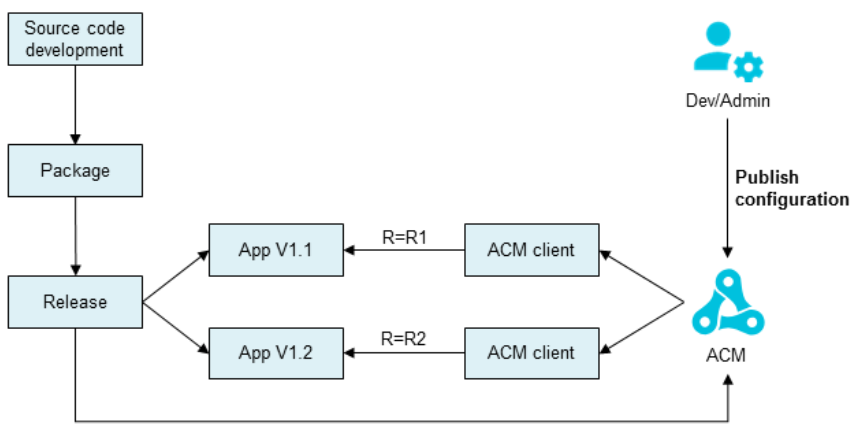
With Alibaba Cloud ACM, microservices can be configured and managed without any issues. All of the critical application configurations are served to ACM. Whenever new configurations are ready to be published, it goes through a direct implementation process and does not require repackaging. The whole process supports real-time execution.
Some of the benefits of ACM with microservices are listed below:
Alibaba Cloud ACM supports administration functions, such as service routing, downgrading, authentication, and rate limiting. With multiple services in a distributed architecture, it is an essential part of management to optimize the whole scenario using an RPC framework, such as REST APIs or HSF.
Any application scenario requires throttling based on traffic requirements. Service degradation and throttling have to be governed based on traffic load requirements. Here, the prime mover is the time taken for these scenarios to execute. ACM makes sure you can achieve this within seconds.
Let's take a look at the architecture for this scenario:
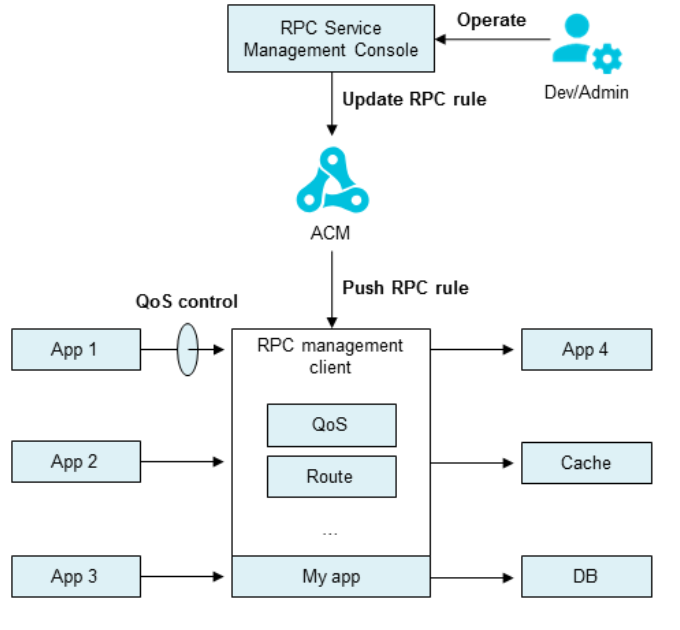
With the distributed architecture, the RPC server utilizes ACM to listen for any information about service rate limiting. The ACM utilizes the governance console and listeners to achieve this and performs the throttling functionality depending on the information provided by the listeners. ACM kicks in to provide configuration for the corresponding server and executes the throttling action.
Some of the benefits associated with ACM within a distributed system are listed below:
Let's take a look at the architecture for that ACM follows this use-case scenario:
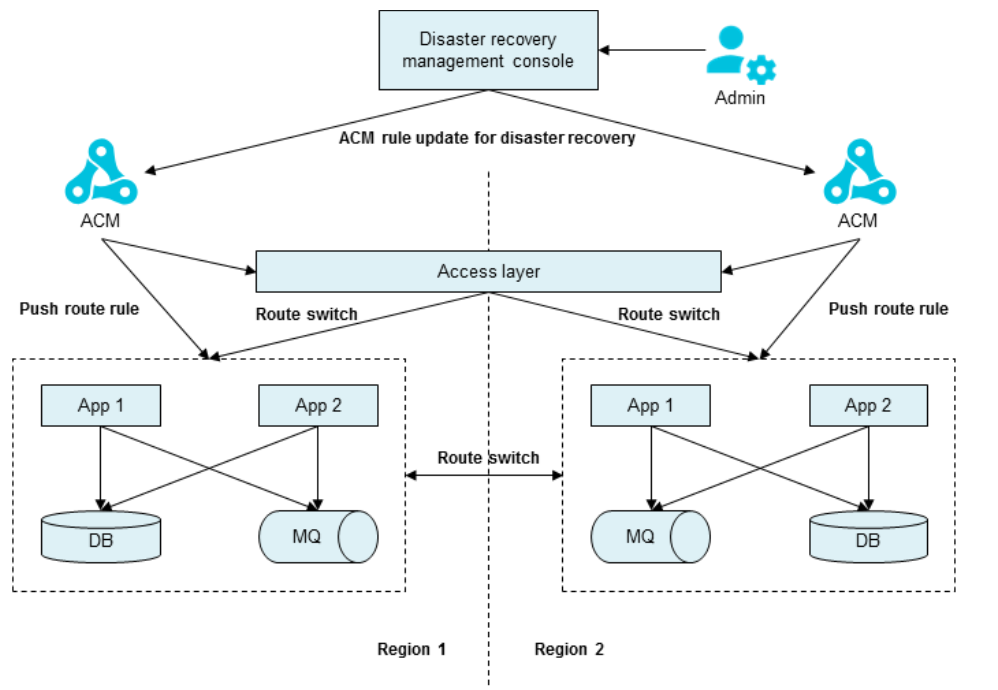
Some of the main benefits offered by the Alibaba Cloud ACM in this scenario are listed below:
The multi-site disaster recovery architecture with Alibaba Cloud ACM offers quick business recovery and lower requirements. It is highly effective and very simple to maintain.
Alibaba Cloud ACM enables the push of core algorithms and other relevant routing rules for a multi-site scenario. High Availability is maintained as ACM dynamically pushes the information based on requirements. During a disaster recovery scenario, the administrator dynamically pushes the rules to gain control of the situation. ACM automatically handles all of the tasks after that.
The Alibaba Cloud ACM configuration management presents itself as a one-stop solution for e-commerce website configuration management or any website that requires the deployment of web pages based on a continuous pattern. ACM helps by managing application scenarios independently. The architecture focuses on independent static business code with configurations to meet resources.
Let's take a look at the architecture for this scenario:
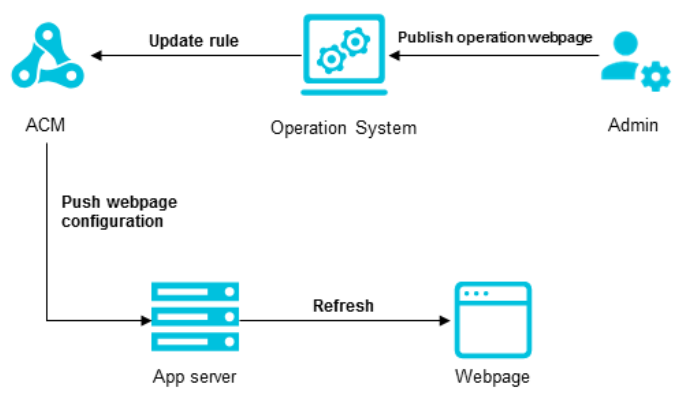
Let's take a look at the architecture of this scenario:
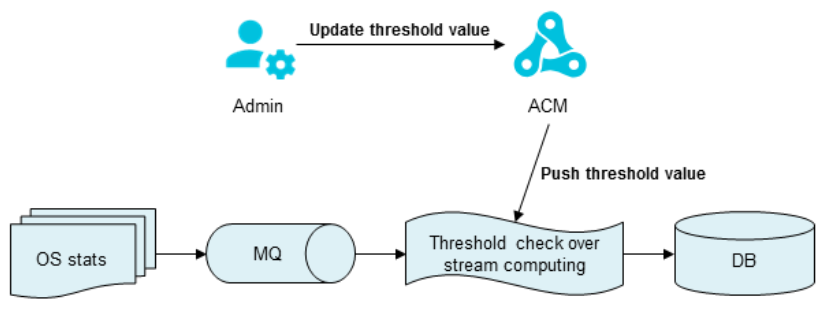
Alibaba Cloud and big data analysis have come a long way. Big-data analysis requires a lot of calculative measures. ACM enables the calculation of these parameters and provides the configuration data based on real-time values. The whole system is dynamically adjusted to suit the business scenario that requires big-data analysis in the first place.
Big-data analysis requires a monitoring system. The monitoring system dynamically adjusts the threshold values to control the real-time computing system. ACM provides the configuration details to adjust the threshold value modification in real-time, so there is no downtime for the application.
Alibaba Cloud ACM is a middleware that provides seamless integration and performance with a wide variety of scenarios. These scenarios cover most of the development to deployment scenarios. Many organizations opt for a hybrid SDLC setup that incorporates a mix of deployment scenarios. We can call this a hybrid mix. Alibaba Cloud ACM outperforms most of the open-source middleware products that help with configuration and application management. ACM provides a suitable, seamless, and highly reliable solution.
Alibaba AI Achieves Identification Accuracy of More than 90% for Textile Quality Inspection

2,599 posts | 765 followers
FollowAlibaba Clouder - November 27, 2020
Alibaba Clouder - September 23, 2019
Alibaba Clouder - June 15, 2020
Alibaba Clouder - April 30, 2019
Aliware - March 19, 2021
Alibaba Clouder - July 26, 2019

2,599 posts | 765 followers
Follow Database Security Solutions
Database Security Solutions
Protect, backup, and restore your data assets on the cloud with Alibaba Cloud database services.
Learn More Backup and Archive Solution
Backup and Archive Solution
Alibaba Cloud provides products and services to help you properly plan and execute data backup, massive data archiving, and storage-level disaster recovery.
Learn More Microservices Engine (MSE)
Microservices Engine (MSE)
MSE provides a fully managed registration and configuration center, and gateway and microservices governance capabilities.
Learn More DevOps Solution
DevOps Solution
Accelerate software development and delivery by integrating DevOps with the cloud
Learn MoreMore Posts by Alibaba Clouder